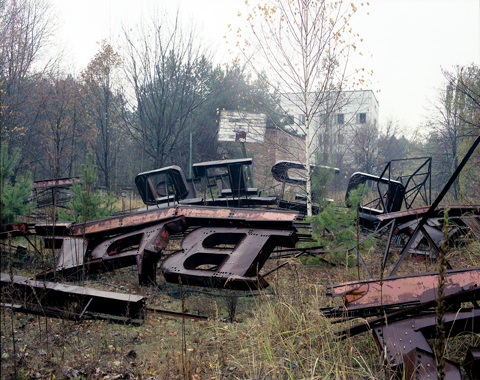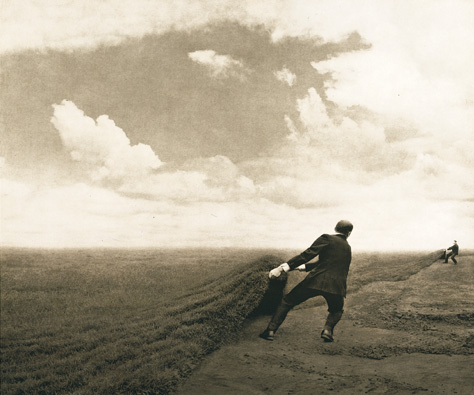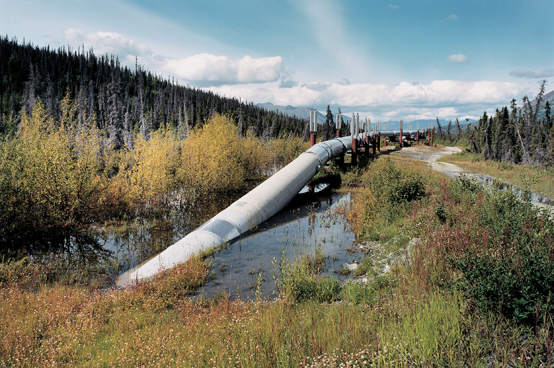[Fall 2008]
National Gallery of Canada, Ottawa
June 27–October 13, 2008
A more timely exhibition of photography there never was. And with a shock-primed title such as Imaging a Shattering Earth: Contemporary Photography and the Environmental Debate, one is put on edge from the beginning. Although the bias in the photographs is toward documentary and old-style landscape, the record of humanity’s disruption, manipulation, and despoiling of these landscapes is disturbing for its ongoing, ever-evolving and almost surreal persis-tence. While documenting nature and the land has been part of the photographer’s role since its inception, many of these works focus on landscapes in transition, and, more interestingly on landscapes that are forever beautiful with or without pollution. Indeed, a push-and-pull between aesthetics and information characterizes many of these works.
Certain photographers’ works are brought into a more public viewing through this show. John Ganis’s images of landfill sites in Michigan and Oklahoma are seemingly innocent in their traditional presentation, yet they presage the further expansion on this subject by Toronto’s Ed Burtynsky and California’s David Maisel. Similarly, Emmet Gowin’s Aeration Pond, Toxic Water Treatment Facility; Pine Bluff, Arkansas (1989) is toxic culture at its most unsettling. We see a bath full of forms floating like some hydra in waiting.
Among noteworthy surprises in this exhibition are the posed photos by Robert and Shana Parke Harrison, which have a wit and humour that gets the message across without grinding you down. Their images are performance enactments that recall German Dieter Appelt’s set-up structures, but without the solemn gravity and narrow aesthetic confinement. The Guardian has Robert dressed in a formal suit, wearing wings made of branches, and perched on two precarious tree/legs; in another photograph he is in mid-air, held to Earth by a giant fish hook while trying to harness the clouds. There’s hope in those clouds, and the tonality of these photos carries a documentary historical cadence.
Emmet Gowin’s photographs are also fascinating. The aerial view Off Road Traffic Pattern along the Northwest Shore of Great Salt Lake, Utah (1998) is, to all intents and purposes, a collaborative land-art work enacted by many vehicles. The image effectively communicates our impact on the land yet is an interesting land-scaled photograph. Gowin’s aerial view Weapon Disposal Trenches, Tooele Army Depot, Utah (1991) is almost like an art brut artwork. The engineered incisions in the landscape operate as markings and look as primitive as the Lascaux cave paintings! David Maisel’s The Lake Project (2001–02) photographs are like those microcosmic images we see in biology books, and equally interesting. (See Ciel variable 76, pp. 14–17 for an interview with David Maisel.)
Other photographs in Imaging a Shattering Earth document the resource industries’ incursions on a more pristine nature. In John Ganis’s Alaska Pipeline, North of Valdez, Alaska (2001), we see a pipe disappear, snakelike, under the muskeg. Jonathan Long documents the ageing of landscapes as the lasting effects of pollution eventually come to form the look of the land. A series of trees – broken stumps – standing in a seemingly endless and mercurial swamp of unnamed and polluted orange liquid says it all. Ed Burtynsky, who has more recently been investigating northern Alberta’s oil sands, as economies of scale work on what was once nature to turn it into toxic sludge and scraped landscapes empty of topsoil, has a strong image from China’s Three Gorges Dam project on the Yangtze River. Winnipeg-based David MacMillan’s photographs of abandoned classrooms in the Ukraine near Chernobyl offer some idea of what is still there long after the exodus. The way weather has worked on peeling wall paint and a portrait of Lenin at Pripyat School, and the way an entire classroom has remained untouched – curtains, toys, and shelving still in place – are reminiscent of scenes in Nevil Shute’s post-atomic novel On the Beach (1957). David T. Hanson’s Wasteland series brings together maps, aerial views, and government reports presenting toxic landscapes in the United States.
Given the immensity of this subject and the range of approaches taken by the photographers contributing to this exhibition, it is surprising how small the selection of works actually is. It would have broadened our understanding to include Canadian photographers’ works, such as Thaddeus Holownia’s Pipeline series, Bob del Tredici’s Nuclear Map of Canada series, and Roy Arden’s more urban works, to name a few. Nevertheless, this show, orchestrated by Martha Hanna (director of the Canadian Museum of Contemporary Photography) and curated by Claude Baillargeon (of Oakland University, California), proves that photography can play an active role in heightening our awareness of social and ecological issues.
John Grande’s recent books include Dialogues in Diversity: Art from Marginal to Mainstream (www.paripublishing.com) and Art Allsorts: Writings on Art & Artists (www.lulu.com). In the summer of 2008, he curated two international ephemeral-art exhibitions at the Royal Botanical Gardens in Hamilton, Ontario, and in Sackville, New Brunswick, selected as cultural capital of Canada for 2008.



